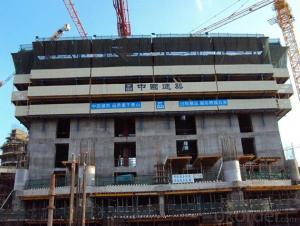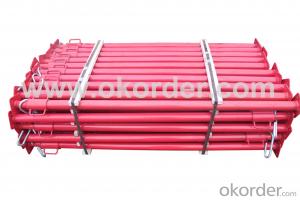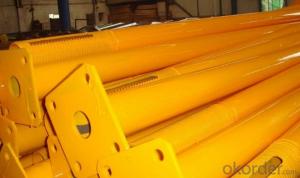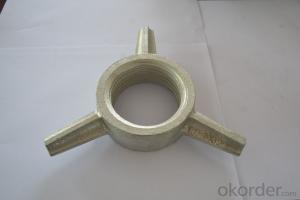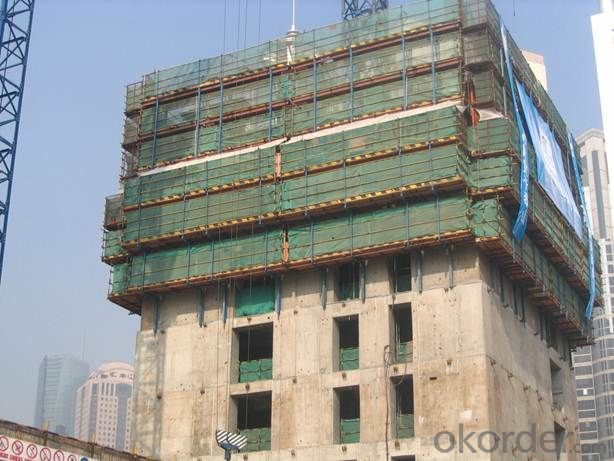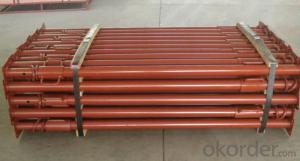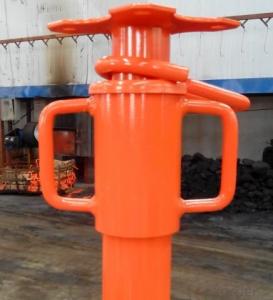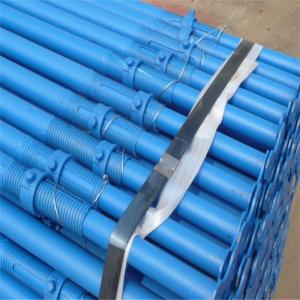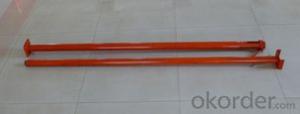Timber Beam Formwork-Climbing Formwork
- Loading Port:
- China Main Port
- Payment Terms:
- TT OR LC
- Min Order Qty:
- -
- Supply Capability:
- -
OKorder Service Pledge
Quality Product, Order Online Tracking, Timely Delivery
OKorder Financial Service
Credit Rating, Credit Services, Credit Purchasing
You Might Also Like
Thepower of the Autoclimbing Formworkis the hydraulic system, whichincludes theoil cylinder and two commutators etc. Thecommutators can control the climbing of climbingrail and the bracket. The steel rail
andthe bracket can inner-climbing, so thewhole system will climb upsteadily.
Cranesare not needed during the constructing. It is easy tooperate, highly efficient and safe. It is thebest choice for the construction of highbuildings and bridges.
Characteristics
Safety:
1.Thesystem can climbintegrallyor separately.
2.Theclimbing process is steady,synchronousand safe.
3.Excellentoperating platformhandrailand aislecanbe liftedtogetherwith the formwork.
4.Theclimbing speed is quick, which can shorten the construction period and reduce the construction cost.
- Q:Are steel props adjustable? If so, how?
- Steel props, also referred to as adjustable steel props or steel acrow props, possess the capability to be adjusted according to different construction needs. These props are commonly utilized in the construction industry to offer temporary support to walls, ceilings, beams, and other structural components. The primary advantage of steel props lies in their ability to be modified. This adjustability allows them to be set at varying heights, catering to diverse construction requirements. Typically, the adjustment mechanism of steel props comprises an outer tube and an inner tube. The outer tube is usually larger and features multiple holes at regular intervals. The inner tube, which fits inside the outer tube, possesses a pin that can be inserted into one of the holes in the outer tube to secure the desired height. To adjust a steel prop, the initial step involves loosening the locking mechanism, typically a pin or a collar responsible for holding the inner tube in place. Once the locking mechanism is loosened, the inner tube can be extended or retracted to attain the desired height. After adjusting the height, the inner tube is secured by inserting the pin into the appropriate hole in the outer tube. Subsequently, the locking mechanism is tightened to ensure stability. The versatility of steel props stems from their adjustability, rendering them suitable for a wide range of construction applications. These props can support varying load capacities, and their adjustable nature facilitates quick and effortless installation, as well as modifications throughout the construction process.
- Q:Do steel props require any special permits or certifications?
- Yes, in many cases, steel props require special permits or certifications. The exact requirements may vary depending on local regulations and the specific use of the steel props. For construction projects, steel props are commonly used to support temporary structures, such as formwork or scaffolding systems. In these cases, the use of steel props may require permits from local building authorities to ensure compliance with safety standards and regulations. The permits may involve inspections to verify the quality and stability of the props, as well as the overall safety of the construction site. Furthermore, steel props used in certain industries, such as oil and gas, may require specific certifications. These certifications are often related to the quality and strength of the props, ensuring they can withstand the specific conditions and loads they will be subjected to. Examples of relevant certifications include ISO certifications, API certifications, or certifications from other industry-specific regulatory bodies. It is important to consult with local building authorities and relevant industry regulations to determine the specific permits or certifications required for the use of steel props. Failing to comply with these requirements can result in penalties, legal issues, and, most importantly, compromised safety on the project site.
- Q:Can steel props be used in tunnel construction projects?
- Yes, steel props can be used in tunnel construction projects. Steel props are commonly used to support and stabilize excavations during construction activities. In tunnel construction, steel props can be used to provide temporary support to the tunnel walls and ceiling until a permanent support system, such as shotcrete or rock bolts, is installed. Steel props are adjustable, which allows for flexibility in supporting various tunnel shapes and sizes. They are also durable and can withstand heavy loads, making them suitable for tunnel construction projects where stability and safety are crucial. Additionally, steel props can be easily moved and reused in different sections of the tunnel, making them a cost-effective choice for supporting temporary excavations during tunnel construction.
- Q:How do steel props contribute to the overall safety of construction sites?
- Playing a crucial role in ensuring construction site safety are steel props, also known as adjustable steel props or acrow props. These durable and sturdy supports are designed to provide temporary structural support and stability during construction activities, minimizing the risk of accidents and enhancing worker, equipment, and environmental safety. A primary contribution of steel props to construction site safety lies in their ability to bear heavy loads and offer reliable support. These props are specially engineered to withstand immense pressure and maintain structural integrity, which is vital when supporting structures like walls, ceilings, or beams during construction or renovation. By securely propping up these temporary structures, steel props prevent collapse and potential harm to workers and nearby structures. Adjustability is another essential aspect of steel props. With their telescopic design, these props can easily be extended or retracted to the desired height, enabling precise and accurate support in different construction scenarios. This adjustability ensures that temporary structures receive adequate support and allows workers to maintain a level and stable working environment, reducing the risk of slips, trips, and falls. Steel props also provide a versatile solution to various construction challenges. They can be used for formwork support, trench shoring, facade retention, and temporary propping, offering a flexible and adaptable approach to construction support. This versatility aids in maintaining stability and mitigating potential hazards on construction sites. Furthermore, steel props are designed with safety features like locking pins and adjustable attachments that prevent accidental displacement or collapse. These additional measures ensure that props remain securely in place, even under dynamic loads or adverse weather conditions, further enhancing construction site safety. In conclusion, steel props significantly contribute to construction site safety by offering reliable support, adjustability, versatility, and safety features. By preventing structural collapse, maintaining stability, and creating a secure working environment, these props play a vital role in safeguarding workers, equipment, and the surrounding areas during construction activities.
- Q:Can steel props be used for temporary support in bridges?
- Yes, steel props can be used for temporary support in bridges. Steel props are often used during bridge construction or repair projects to provide temporary support and ensure the stability of the structure until permanent supports are in place.
- Q:How do you ensure the stability of a steel prop on uneven terrain?
- To ensure the stability of a steel prop on uneven terrain, there are several important steps you can take: 1. Choose the right prop: Select a steel prop with a wide base or footplate. A larger base will provide better stability and prevent sinking into softer ground. 2. Prepare the ground: Before placing the prop, clear away any debris or obstacles on the terrain. Level out the surface as much as possible to minimize unevenness. 3. Use a stable platform: If the ground is extremely uneven, consider using a stable platform such as a wooden or metal board. This will help distribute the weight of the prop evenly and prevent it from sinking or tilting. 4. Secure the prop: Ensure that the prop is securely positioned on the ground. If necessary, use stakes or anchors to anchor it to the terrain. This will prevent any movement or instability caused by external factors such as wind or vibrations. 5. Regular inspections: Regularly inspect the prop and the surrounding area. Look for signs of sinking, tilting, or instability. If any issues are identified, take immediate action to address them, such as adjusting the position of the prop or reinforcing the ground. 6. Monitor load distribution: If the steel prop is supporting a heavy load, make sure the weight is evenly distributed. Uneven load distribution can cause instability, so it is crucial to check and adjust the load as needed. 7. Seek professional advice: If you are unsure about the stability of the steel prop on uneven terrain, it is always advisable to consult with a structural engineer or a professional with expertise in construction safety. They can provide specific recommendations based on the terrain and load requirements. By following these steps, you can ensure the stability of a steel prop on uneven terrain, minimizing the risk of accidents or structural failures.
- Q:Can steel props be used for supporting temporary catwalks?
- Yes, steel props can be used for supporting temporary catwalks. Steel props, also known as adjustable steel props or steel shores, are commonly used in construction and scaffolding to provide temporary support to various structures, including catwalks. These props are designed to be adjustable in height, making them versatile and suitable for different applications, including supporting temporary structures like catwalks. Steel props offer high load-bearing capacity and stability, making them a reliable choice for providing support to catwalks, which are typically used for accessing elevated areas during construction, maintenance, or events. Additionally, steel props are easy to assemble and disassemble, making them convenient for temporary structures that may need to be set up and removed quickly. Overall, steel props are a suitable and commonly used choice for supporting temporary catwalks.
- Q:Are steel props suitable for supporting scaffolding?
- Indeed, steel props prove to be a suitable option for supporting scaffolding structures. Recognized as adjustable steel props or acrow props, these props are extensively employed in construction or renovation endeavors to offer temporary support. Constructed from superior-grade steel, they possess remarkable strength and dependability when it comes to sustaining substantial burdens. The height of steel props can be effortlessly modified to meet specific requirements, ensuring stability and safeguarding workers laboring on scaffolding platforms. Notably, their versatility enables their application in diverse construction scenarios, consequently establishing them as a favored choice within the industry.
- Q:Can steel props be used for supporting temporary aerial platforms or lifts?
- Supporting temporary aerial platforms or lifts can be achieved using steel props. These props, also referred to as adjustable steel props or scaffolding props, are commonly utilized in construction projects to offer temporary support for structures or platforms. Their adjustable height feature makes them suitable for various applications, including supporting aerial platforms or lifts. Steel props are renowned for their strength and stability, making them a dependable choice for establishing a secure and sturdy foundation for temporary platforms or lifts. Moreover, their height can be easily modified, providing flexibility in determining the desired elevation for the platforms or lifts. However, it is imperative to ensure the proper installation of steel props and adherence to required safety standards to guarantee the safety of workers and the stability of the supported structure.
- Q:What is the maximum lateral load that a steel prop can withstand?
- The maximum lateral load that a steel prop can withstand depends on various factors such as the specific type and size of the prop, its design and construction, as well as the conditions and environment in which it is being used. It is essential to refer to the manufacturer's specifications and guidelines for accurate information regarding the maximum lateral load capacity of a particular steel prop.
1. Manufacturer Overview |
|
|---|---|
| Location | |
| Year Established | |
| Annual Output Value | |
| Main Markets | |
| Company Certifications | |
2. Manufacturer Certificates |
|
|---|---|
| a) Certification Name | |
| Range | |
| Reference | |
| Validity Period | |
3. Manufacturer Capability |
|
|---|---|
| a)Trade Capacity | |
| Nearest Port | |
| Export Percentage | |
| No.of Employees in Trade Department | |
| Language Spoken: | |
| b)Factory Information | |
| Factory Size: | |
| No. of Production Lines | |
| Contract Manufacturing | |
| Product Price Range | |
Send your message to us
Timber Beam Formwork-Climbing Formwork
- Loading Port:
- China Main Port
- Payment Terms:
- TT OR LC
- Min Order Qty:
- -
- Supply Capability:
- -
OKorder Service Pledge
Quality Product, Order Online Tracking, Timely Delivery
OKorder Financial Service
Credit Rating, Credit Services, Credit Purchasing
Similar products
New products
Hot products
Hot Searches
Related keywords
